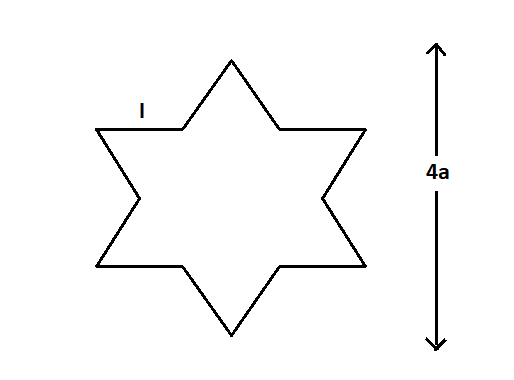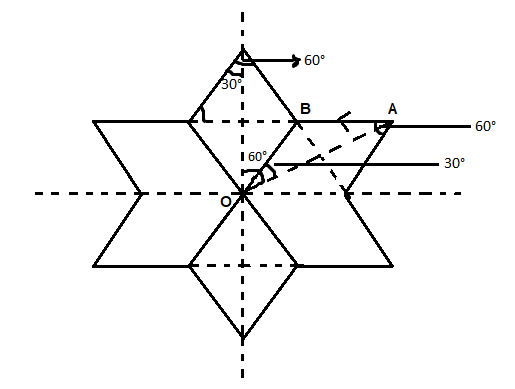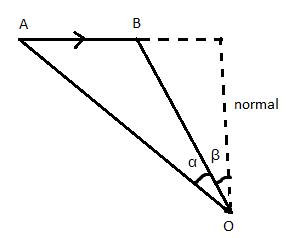
A symmetric star conducting wire loop is carrying a steady current $I$ as shown in the figure. The distance between the diametrically opposite vertices of the star is $4a$. The magnitude of the magnetic field at the center of the loop is

(A) $\dfrac{{{\mu _0}I}}{{4\pi a}}6\left( {\sqrt 3 - 1} \right)$
(B) $\dfrac{{{\mu _0}I}}{{4\pi a}}6\left( {\sqrt 3 + 1} \right)$
(C) \[\dfrac{{{\mu _0}I}}{{4\pi a}}3\left( {\sqrt 3 - 1} \right)\]
(D) $\dfrac{{{\mu _0}I}}{{4\pi a}}3\left( {2 - \sqrt 3 } \right)$
Answer
216.3k+ views
Hint We have a conductor in the shape of a symmetric star. The current $I$ is flowing through the conductor. We know that there will be a magnetic field associated with the charges moving through a conductor. The total length between two diametrically opposite vertices of the star is given and we have to find the magnitude of the magnetic field at the center of the star.
Complete step by step answer:
According to the right-hand thumb rule, the magnetic field due to the star-shaped current-carrying conductor will be in the upward direction. Since there are $6$ vertices, and each vertex has two sides the total magnetic field will be $12$ times the field due to one side.

Let us consider any one of the sides as $AB$.

The field at a point $O$ can be obtained by joining $A$ and $B$ as shown in the figure.
The dotted lines show the normal perpendicular to the point $O$.
The general formula for the field at the point $O$can be written as,
$B = \dfrac{{{\mu _0}I}}{{4\pi a}}\left( {\sin \alpha - \sin \beta } \right)$
From the above two diagrams, we get
$\alpha = {60^ \circ }$ and $\beta = {30^ \circ }$
Where $B$ stands for the magnetic field, ${\mu _0}$ stands for the permeability of free space, $I$ stands for the current, $a$ stands for the distance between the conductor and the point where we have to find the electric field, and $\alpha $and $\beta $ are the angles as shown in the figure.
Let us assume that the field due to the side $AB$ at the center of the star is ${B_{1.}}$
The field ${B_1}$ can be written as,
${B_1} = \dfrac{{{\mu _0}I}}{{4\pi a}}\left( {\sin {{60}^ \circ } - \sin {{30}^ \circ }} \right)$
We know that $\sin {60^ \circ } = \dfrac{{\sqrt 3 }}{2}$and $\sin {30^ \circ } = \dfrac{1}{2}$
Substituting the value, we get
${B_1} = \dfrac{{{\mu _0}I}}{{4\pi a}}\left( {\dfrac{{\sqrt 3 }}{2} - \dfrac{1}{2}} \right)$
This is the magnetic field due to one side of the star.
We know that the total magnetic field at the center of the star will be $12$ times ${B_1}$
Therefore, we can write the total magnetic field at the center of the star will be,
$B = 12 \times \dfrac{{{\mu _0}I}}{{4\pi a}}\left( {\dfrac{{\sqrt 3 }}{2} - \dfrac{1}{2}} \right)$
This will be,
$B = \dfrac{{{\mu _0}I}}{{4\pi a}}6\left( {\sqrt 3 - 1} \right)$
The answer is: Option (A): $\dfrac{{{\mu _0}I}}{{4\pi a}}6\left( {\sqrt 3 - 1} \right)$
Note
The strength of the magnetic field will be directly proportional to the current through the conductor. The magnetic field will also depend on the length of the conductor that we consider. It is also proportional to the sine angle between the element in the direction of current and the line joining the element and the point of consideration. The magnetic field is inversely proportional to the distance between the conductor and the point of consideration.
Complete step by step answer:
According to the right-hand thumb rule, the magnetic field due to the star-shaped current-carrying conductor will be in the upward direction. Since there are $6$ vertices, and each vertex has two sides the total magnetic field will be $12$ times the field due to one side.

Let us consider any one of the sides as $AB$.

The field at a point $O$ can be obtained by joining $A$ and $B$ as shown in the figure.
The dotted lines show the normal perpendicular to the point $O$.
The general formula for the field at the point $O$can be written as,
$B = \dfrac{{{\mu _0}I}}{{4\pi a}}\left( {\sin \alpha - \sin \beta } \right)$
From the above two diagrams, we get
$\alpha = {60^ \circ }$ and $\beta = {30^ \circ }$
Where $B$ stands for the magnetic field, ${\mu _0}$ stands for the permeability of free space, $I$ stands for the current, $a$ stands for the distance between the conductor and the point where we have to find the electric field, and $\alpha $and $\beta $ are the angles as shown in the figure.
Let us assume that the field due to the side $AB$ at the center of the star is ${B_{1.}}$
The field ${B_1}$ can be written as,
${B_1} = \dfrac{{{\mu _0}I}}{{4\pi a}}\left( {\sin {{60}^ \circ } - \sin {{30}^ \circ }} \right)$
We know that $\sin {60^ \circ } = \dfrac{{\sqrt 3 }}{2}$and $\sin {30^ \circ } = \dfrac{1}{2}$
Substituting the value, we get
${B_1} = \dfrac{{{\mu _0}I}}{{4\pi a}}\left( {\dfrac{{\sqrt 3 }}{2} - \dfrac{1}{2}} \right)$
This is the magnetic field due to one side of the star.
We know that the total magnetic field at the center of the star will be $12$ times ${B_1}$
Therefore, we can write the total magnetic field at the center of the star will be,
$B = 12 \times \dfrac{{{\mu _0}I}}{{4\pi a}}\left( {\dfrac{{\sqrt 3 }}{2} - \dfrac{1}{2}} \right)$
This will be,
$B = \dfrac{{{\mu _0}I}}{{4\pi a}}6\left( {\sqrt 3 - 1} \right)$
The answer is: Option (A): $\dfrac{{{\mu _0}I}}{{4\pi a}}6\left( {\sqrt 3 - 1} \right)$
Note
The strength of the magnetic field will be directly proportional to the current through the conductor. The magnetic field will also depend on the length of the conductor that we consider. It is also proportional to the sine angle between the element in the direction of current and the line joining the element and the point of consideration. The magnetic field is inversely proportional to the distance between the conductor and the point of consideration.
Recently Updated Pages
Wheatstone Bridge Explained: Working, Formula & Uses

Young’s Double Slit Experiment Derivation Explained

JEE Atomic Structure and Chemical Bonding important Concepts and Tips

JEE Amino Acids and Peptides Important Concepts and Tips for Exam Preparation

Electricity and Magnetism Explained: Key Concepts & Applications

Chemical Properties of Hydrogen - Important Concepts for JEE Exam Preparation

Trending doubts
JEE Main 2026: Application Form Open, Exam Dates, Syllabus, Eligibility & Question Papers

Derivation of Equation of Trajectory Explained for Students

Hybridisation in Chemistry – Concept, Types & Applications

Understanding the Angle of Deviation in a Prism

Understanding Collisions: Types and Examples for Students

How to Convert a Galvanometer into an Ammeter or Voltmeter

Other Pages
JEE Advanced Marks vs Ranks 2025: Understanding Category-wise Qualifying Marks and Previous Year Cut-offs

Ideal and Non-Ideal Solutions Explained for Class 12 Chemistry

Degree of Dissociation: Meaning, Formula, Calculation & Uses

Understanding Electromagnetic Waves and Their Importance

Understanding the Electric Field of a Uniformly Charged Ring

Understanding Average and RMS Value in Electrical Circuits




